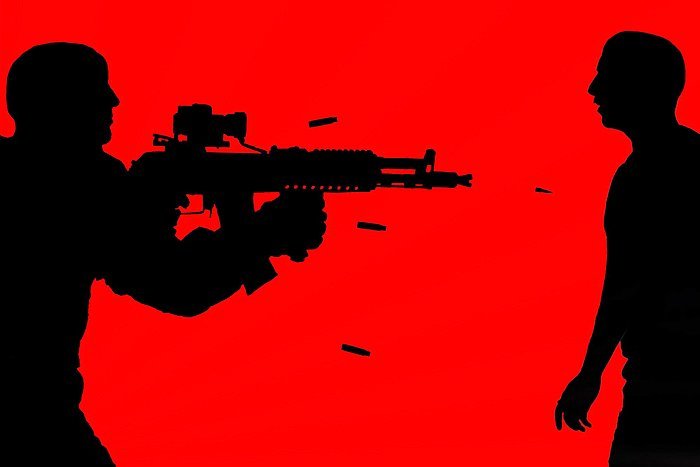The facts of the case are simple. On August 19, police were called because of reports of a man armed with a knife. Shortly after the call, police encountered Browning, 54, less than a mile away. Within less than a minute after Stephenson walked to the front of his cruiser, he would put four .223 rounds into the chest of Browning.
Browning was not holding a knife. Instead, he was 'armed' with a water main key — a thin metal rod used for turning on and of water meters and waste valves.
The police agree on all of the above. However, it is what happened after Stephenson killed Browning that is the subject of controversy. Police claim Browning charged the officer. But, from what we can see on the dashcam, this is a clear fabrication.
As the video begins, Stephenson is seen rounding the front of his cruiser. The two exchange words as Browning threatens Stephenson and vice versa. However, at no point do we see anyone charge anyone. In fact, Browning was barely inching toward Stephenson when the officer opened fire.
At no point was a less than lethal option even considered by Stephenson in the video. At no point did Stephenson back up. For slowly walking toward a police officer with a thin metal rod, Browning was put to death by his judge, jury, and executioner — Lt. Daniel Stephenson.
Immediately after the killing in August, police investigators released a statement to the media claiming that a man ran at the officer. And since the investigation, no one in the media has questioned it — even as the video clearly shows it is false.
An 'investigation' conducted by the Hamilton County Sheriff's Office found the use of deadly force by Lt. Daniel Stephenson was justified under T.C.A. § 39-11-620 for the following reasons:
- Lt. Stephenson was wearing an ERPD uniform and operating a marked patrol car, which clearly identified him as a police officer.
- Lt. Stephenson exhausted all reasonable means to apprehend Browning through a lengthy negotiation and repetitive commands prior to the use of deadly force.
- Lt. Stephenson had probable cause to believe Browning posed a threat of serious bodily injury or death as Browning approached with a water main key while yelling that Lt. Stephenson would have to kill him or else he would kill Lt. Stephenson.
Courage, these days, is a word not fit for so many cops as true courage is not immediately resorting to deadly force because you perceive a threat. No, true courage is the preservation of life, even if it means you might get a little bruised up in the process.
Perhaps Stephenson was scared of losing his job for NOT killing Browning, as was the case with a cop in West Virginia. Weirton police officer Stephen Mader exhibited extreme bravery and restraint earlier this year when he chose not to kill a suicidal man. For displaying such courage and reserve, Mader's department fired him.
On May 6, 2016, Mader responded to a call about a domestic incident. When he showed up to the call, Mader confronted Ronald D. Williams Jr., 23, who was armed and in a diminished mental state. Madar said that he began talking to the young man in his "calm voice." "I told him, 'Put down the gun,' and he's like, 'Just shoot me.' And I told him, 'I'm not going to shoot you brother.' Then he starts flicking his wrist to get me to react to it.
"I thought I was going to be able to talk to him and de-escalate it. I knew it was a suicide-by-cop" situation. Even after the 23-year-old father twitched his wrist and waved around the gun, Mader did not feel threatened enough to kill him. His restraint was nothing short of remarkable.
However, this restraint would be in vain. Just as Mader successfully began to diffuse and de-escalate the situation — backup arrived. The cops who showed up were not like Mader. As soon they got out of the vehicle, one of the cops immediately fired and shot Williams in the back of the head, killing him.
Another cop in Utah proved his heroism as well, and he faced a far more dangerous situation than Stephenson. On New Year's Eve of this year, 36-year-old Brandon Morgan was in the midst of an obvious mental breakdown and became suicidal. He armed himself with a machete and a blowtorch and scared his family to the point that they called police.
One of the officers responding to the call captured the interaction on his body cam, and it shows something amazing. As the officer enters the house, with his service pistol drawn, he is confronted by a man armed with a machete and a blowtorch. In 99.99 percent of incidents like this, police would have killed the man. It would be a blip on the news, and the 'killed by police' death toll tally would have rolled up another notch.
But these deaths are not always necessary. What the cop in the video below, and the numerous videos out of Europe, show us is that police don't have to kill.
In the video, the officer came in contact with the armed man, he then made the choice to put his gun away and pull out his taser. "He threatened the officer with a machete, officer tasered him, and then they dragged him out of the house, and the house was engulfed in fire," said Chief Doug Diamond of the West Jordan Police Department explaining what was captured on the officer's body cam.
The officer's decision to resort to a taser instead of his gun was a split second moment of logic. He knew that Morgan didn't have to die for this situation to be put under control, and he acted with the appropriate force necessary to end the threat.
Because of the actions of this officer, Brandon Morgan will live to see his children again and possibly get the mental help that he needs to make a recovery. Sadly, Browning will not get that chance.
Matt Agorist is an honorably discharged veteran of the USMC and former intelligence operator directly tasked by the NSA. This prior experience gives him unique insight into the world of government corruption and the American police state. Agorist has been an independent journalist for over a decade and has been featured on mainstream networks around the world.





Just don't call the police, they are mostly useless liars. And that ain't bad enough, the liars are considered totally true in a court room. I've spend 4 and a half years in jail, thanks to lying cops in Alaska court rooms.